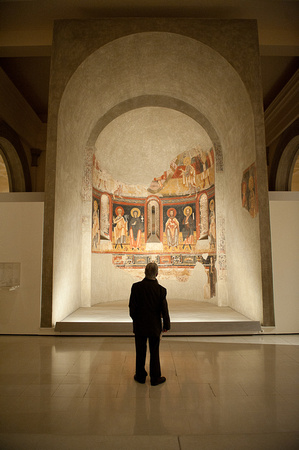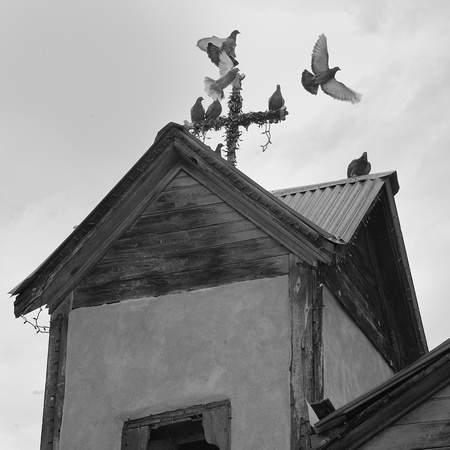|
I hope you find something within the writings of this blog that will educate, inspire, or if nothing else ... make you laugh. And with any luck, the things that make you laugh will not be the things that I intended to educate or inspire. - Mike A Word on Style
  All artists have a certain style that defines the work they create and how they create it. Their way of seeing the world and conveying it in their art for the rest of us to enjoy. We either appreciate an artist’s style or we don’t. So before we get into all the good stuff, let me address this elusive concept of style. People ask me how they can develop their style, and I have come to the conclusion that you shouldn’t worry about it. Here’s why: You already have a style, and it is developing as we speak.
All artists have a certain style that defines the work they create and how they create it. Their way of seeing the world and conveying it in their art for the rest of us to enjoy. We either appreciate an artist’s style or we don’t. So before we get into all the good stuff, let me address this elusive concept of style. People ask me how they can develop their style, and I have come to the conclusion that you shouldn’t worry about it. Here’s why: You already have a style, and it is developing as we speak.That’s right: Just as you already have a personality, you already have a style all your own. Of course, your style will change as you mature, as your view of the world changes, and as you develop your craft, hone your skills, and gain further insight and knowledge of the art form you are embracing. We are all unique, and we all naturally make different statements in life. The same will be true of your art. Your style will be evident as long as you are not copying someone else’s style. Don’t try to be someone else. Our personality develops from our experiences, our surroundings, and our interaction with life as we pass through it. From the relationships we choose to have and the people that influence us. It is who we are when we just “are.” Your style develops in much the same way. You don’t seek to develop your personal- ity, and I don’t think you need to seek to develop your style, either. It just develops. You interact with the world through your personality, and your style is pretty much the same: It is how you interact with the world through your art. I suppose the core of all of this is to be true to yourself. We are continually learning new things and finding new ways to employ that knowledge in our craft. We stretch ourselves and sometimes do things that may not feel natural. Just make sure that even when you’re on the edge, you are always being yourself. You were fearfully and wonderfully made by One whose works are wonderful in ways we can’t begin to imagine. Rest in the vision that He has for you, and your style will be obvious, unique, and magnificent. Photography as Worship 
The word icon in its purest form refers to a piece of religious art. It is based on the Greek word for “image,” and so the subtitle of this book, “The art and science of iconic imagery” is particularly suited to the things we will be discussing. Icons originated in the early Eastern Church, and represented a sacred personage, such as Christ or a saint or angel. They were usually painted on a wood surface, and were often venerated as sacred themselves. So an icon was typically an image, or representation, of what was being worshiped, and served as a focus point during worship. It is easy for me to understand the value of something that helps guide people in worship. After all, that is exactly what is happening in the church today, with contemporary music and all the other trappings that make up a modern worship service in the 21st century. These elements guide us as a congregation in the act of worship, and imagery can do the same. Beautiful art can touch us just as profoundly as a worshipful song or a well-crafted sermon can. Which brings us to an interesting point.
There has long been debate as to whether photography is actually art. I suppose believing it is not is easy to understand if you think of photography as simply holding a camera and pushing a button, but I am pretty sure that even now, in the first chapter of this book, you may be realizing that this is not the case at all. The art that is photography is quite obvious when the world is seen through the lenses of some of the pillars of photography, like Ansel Adams, Alfred Stieglitz, or Edward Weston, as well as any number of great contemporary artists like Jack Dykinga or Annie Leibovitz. These photographers and thousands more like them have made an art form out of seeing the world in a certain way and then conveying that vision to their audience. Although we will be putting great emphasis on the tools of photography, it will become very obvious that most of what makes photography art takes place in the eyes of the artist: you—the photographer.
Yes you still need a tripod!
The image of the pennies at right is such a shot. It was shot with a 105mm f2.8 macro lens, and the exposure time was 30 seconds. This falls pretty much outside the boundaries of what most of us would consider a hand held shot. So yes, it required a tripod. Macro photography has very limited depth of field, so to get the amount of focus I did in this shot, I had to stop down to f20. Even stopped down that small, you can still see that focus drops off by the time we get 2 or 3 coins down. Very shallow indeed! So yes, the need for a tripod in modern photography has certainly been reduced, but not eliminated. Especially when we consider that the new batch of cameras are getting really high resolution sensors. This is requiring artists to almost shoot as if they were shooting medium format and that approach has a whole different set of concerns. Then you not only use a tripod, but you wonder if the mirror slap is going to blur the image. What is old is new again... The Best Camera in the World
Yes, I know. It seems so obvious, but we often forget that we have a camera with us almost all the time. Specifically our cell phones. This image of the church door at left was taken in Nashville with my iPhone 4. It is not of the same quality that I would get using my Nikon D800, but I did not have the Nikon with me. If we only take pictures when we have what we think is the right camera, we will miss out on a lot of images. This image may or may not be useable, but it is infinitely more useable than the picture I didn't get with my Nikon! The story I share with folks in my workshops is of a really special birthday I threw for my wife. One of the the things we did was a helicopter tour of Long Beach and Los Angeles. The port of LA, Santa Monica pier, Downtown, Hollywood Blvd, Hollywood Bowl, Hollywood Sign etc. I spent that whole flight wishing I had a video camera with that same iPhone on my belt. As you may or may not know, it shoots pretty ok HD video! I would have been well served to remember that I was carrying the best camera in the world with me.....
Lights ... Camera ... Catchlights!!!
Catchlights are the lights that appear in your subjects eyes when you are using a flash or there is a natural light source in just the right spot to produce them. They are what make eyes come alive in portraiture and they are hardly ever accidental. As you can see in the close up of Loriann's eye, there are a couple of light sources that are quite obvious. On the left is a shoot thru umbrella and on the right is a square soft box. People don't usually notice these, but now that they have been pointed out to you, go look at some of the fashion shots of models in some of your favorite magazines. Getting those eyes to sparkle has a lot more to do with the photographer than you might have thought!  
« Older Posts
© mike overlin PHOTOGRAPHY
|



